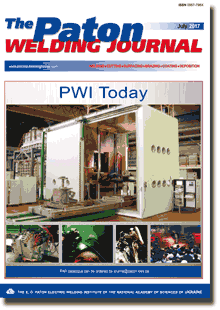| 2017 №07 (08) |
DOI of Article 10.15407/tpwj2017.07.09 |
2017 №07 (01) |

The Paton Welding Journal, 2017, #7, 43-47 pages
Influence of preheating parameters and local heat treatment on structure and properties of dispersion-strengthened joints of silicon-containing titanium alloys made by electron beam welding
S.V. Akhonin, E.L. Vrzhizhevsky, V.Yu. Belous and I.K. Petrichenko
E.O. Paton Electric Welding Institute, NASU 11 Kazimir Malevich Str., 03680, Kiev, Ukraine. E-mail: office@paton.kiev.ua
Abstract
Titanium alloys have high strength and corrosion resistance in a broad temperature range. When developing promising alloys, it is necessary to increase both working temperatures of parts and components of future engines, and their specific strength. The work is a study of the influence of preheating and local heat treatment on the structure and properties of EB welded joints of experimental silicon-containing titanium alloys, namely pseudo a-alloy Ti–5.6Al–2.2Sn–3.5Zr–0.4Mo–1V–0.6Si and (a + b)-alloy Ti–4.3Al–4.4Sn–6Zr–1.6Mo–0.7V–4.3Nb–0.4Si. Welded joints of dispersion-strengthened titanium (a + b)-alloy Ti–4.3Al–4.4Sn–6Zr–1.6Mo–0.7V–4.3Nb–0.4Si have higher ultimate strength, reaching 1277 MPa that corresponds to 90 % of that of the alloy proper. Long-term strength s100 at 600 °C temperature of welded joint of Ti–4.3Al–4.4Sn–6Zr–1.6Mo–0.7V–4.3Nb–0.4Si titanium alloy is equal to about 260 MPa that is on the level of 93 % of long-term strength of base metal. 12 Ref., 4 Figures, 3 Tables.
Keywords: titanium, titanium alloy, dispersion strengthening, electron beam welding, structure, properties, strength, long-term strength
Received: 15.05.17
Published: 01.09.17
References
- Mukhin, V.S. (2007) Principles of technology of machine building (aircraft engine building). Ufa: UGATU.
- Ilienko, V.M., Shalin, R.E. (1995) Titanium alloys for aircraft gas-turbine engines. Titan (VILS), 1/2, 25.
- Iliin, A.A., Kolachev, B.A., Polkin, I.S. (2009) Titanium alloys. Composition, structure, properties: Refer. Book. Moscow: VILS-MATI.
- Ivanov, V.I., Yasinsky, K.K. (1996) Efficiency of application of heat-resistant alloys based on Ti3Al and TiAl intermetallics for operation at temperatures of 600–800 oC in aerospace engineering. Tekhnologiya Lyogkikh Splavov, 3, 12–25.
- Solonina, O.P., Glazunov, S.G. (1996) Heat-resistant titanium alloys: Refer. Book. Moscow: Metallurgiya.
- Levitsky, N.I., Matvinets, E.A., Lapshuk, T.V. et al. (2012) Producing complex-doped titanium alloys by method of electron beam skull melting. Metall i Lityo Ukrainy, 4, 6–9.
- Vrzhizhevsky, E.L., Sabokar, V.K., Akhonin, S.V. et al. (2013) Influence of local heat treatment at EBW of titanium alloys with silicide strengthening on mechanical properties of weld metal. The Paton Welding, J., 2, 20–23.
- Lyasotskaya, V.S., Lysenkov, Yu.T., Gerasimenko, A.V. et al. (1985) Influence of local heat treatment on structure and properties of VT6ch alloy welded joints. Avitsionnaya Promyshlennost, 11, 57–59.
- Anoshkin, N.F., Sigalov, Yu.M. (2002) Titanium alloys with higher heat resistance. Tekhnologiya Lyogkikh Splavov, 1, 38–50.
- Zvikker, U. (1979) Titanium and its alloys. Moscow: Metallurgiya.
- Kornilov, I.I., Budberg, P.B. (1961) State diagrams of binary and ternary systems. Moscow: VINITI.
- Markashova, L.I., Akhonin, S.V., Grigorenko, G.M. et al. (2012) Structure and properties of welded joints on titanium alloys containing silicon additions. The Paton Welding J., 11, 6–15.
